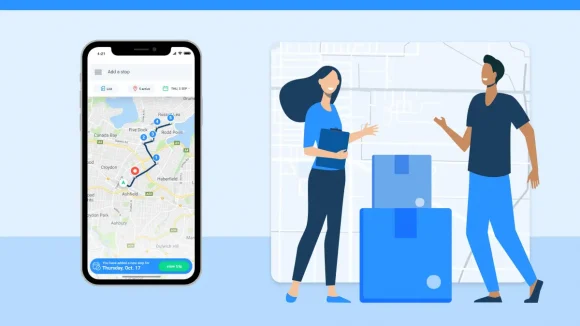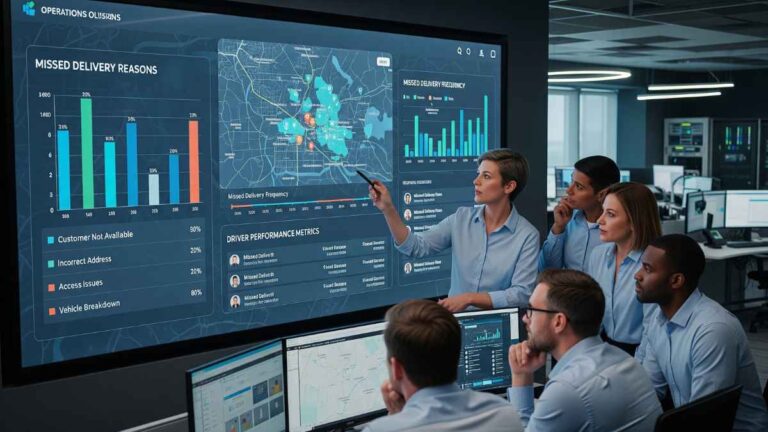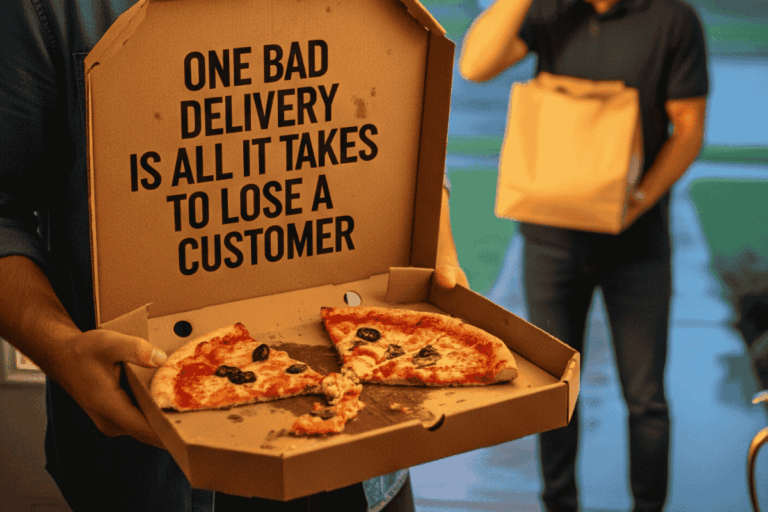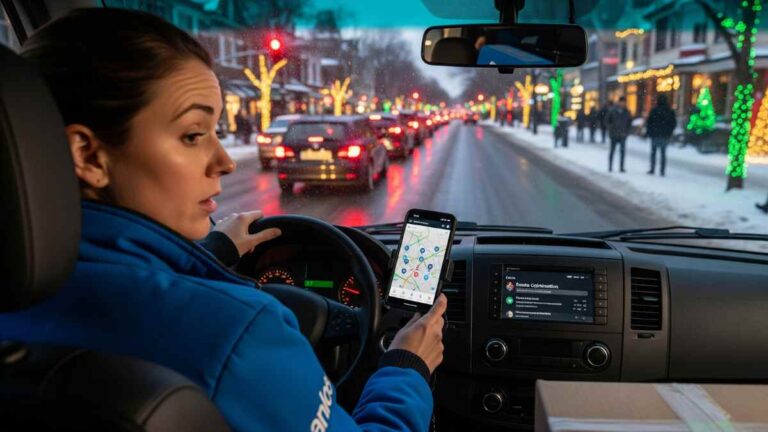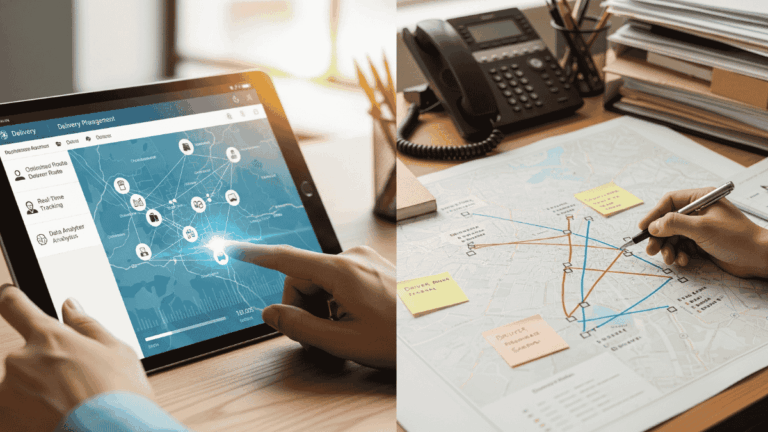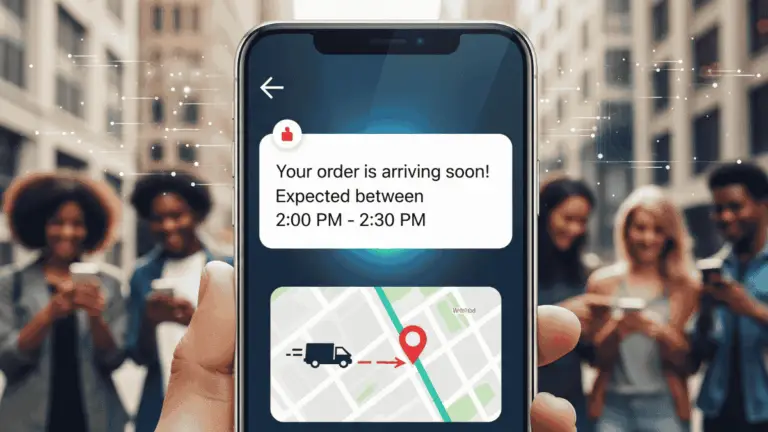Who has time to schedule the most effective routes for their delivery workers week after week? If only there were a way to automate the delivery process so you could focus more of your time on other business activities. That is what route optimization provides! But what is route optimization and how does it work?
Route optimization is the answer you’re looking for if you want to increase your company’s production, improve customer satisfaction, and the performance of your delivery fleet.
What is route optimization?
Finding the most efficient route for a vehicle or fleet of vehicles to travel while taking into account a variety of constraints like time windows, vehicle capacity, and road conditions is a technique known as route optimization. The objective is to travel as little as possible overall and make sure that every stop is made within the allocated delivery windows.
A route planning software is vital as it enables businesses to compete in today’s fast-paced environment. Route optimization can enhance customer service while also reducing costs and saving time. For instance, in the case of delivery services, route optimization helps ensure that products are delivered at a lesser cost and on time.
What is an optimal route?
The most effective route for a vehicle or fleet of vehicles to travel is called an optimal route. This route takes into account a number of restrictions, including time periods, vehicle capacity, and road conditions. Minimizing the overall distance traveled while making ensuring that all stops are made within the specified time slots are the two objectives of determining an ideal route.
Various optimization algorithms assess the input data, including the destinations to be visited, the time slots for each destination, and the vehicle capacity, to establish the best route. These algorithms employ mathematical and computational methods to identify the optimum path that fulfills all the requirements and maximizes the objective function (total distance, time, fuel consumption, etc.).
The type of business or organization, as well as the particular use-case for the optimization, can all affect the various aspects that go into designing the best route. For instance, an optimal route for a delivery service would be one that makes the most stops in the least amount of time, whereas for public transit, an ideal route would be one that has the most stops and serves the most number of passengers.
An ideal route, according to fleet management organizations, would be one that consumes the least amount of fuel and lessens the total wear and tear on the vehicles.
How does route optimization work?
Route optimization is the process of determining the most cost-effective and efficient routes for a vehicle or fleet of vehicles to take, while taking into account a number of restrictions such time frames, vehicle capacity, and road conditions. The aim is to guarantee that all stops are made within the designated time periods and to reduce the overall distance travelled.
Input data
The operation of route optimization begins with input data, which establishes the issue needing to be solved. The places to be visited, the time periods for each destination, and the vehicle capacity are the most critical pieces of information needed for route optimization. You can manually insert locations or import them from a database or spreadsheet. Vehicle capacity is used to guarantee that the algorithm does not exceed the maximum number of people or amount of cargo that the vehicle can carry. Time windows are used to ensure that each stop is performed within a specific time window.
Optimization algorithms
The optimization algorithm begins to examine the information after the input data has been entered in order to identify the best path. For route optimization, a number of optimization techniques can be applied, such as genetic algorithms, simulated annealing, and ant colony optimization.
In order to get the best answer, genetic algorithms replicate the process of natural selection. Through a process of selection, crossover, and mutation, a population of potential pathways is first generated in this procedure. The next generation of routes is created using the routes that perform the best in terms of the target function (total distance, time, fuel consumption, etc.), and this process is repeated until an ideal solution is reached.
An optimization approach based on the heating and cooling process is called simulated annealing. The algorithm begins by picking a starting solution at random, then repeatedly modifies that solution by making minor improvements each time. Depending on whether the adjustments enhance the objective function, the algorithm then “accepts” or “rejects” them. This procedure is comparable to annealing, a physical procedure where a material is heated and then cooled to enhance its qualities.
Ant colony optimization is based on how ant colonies behave and how they determine the quickest route to a food source. This program releases several virtual ants at a starting place. and they then advance towards the final goal by following a series of rules. They leave a “pheromone trail” behind them that other ants can follow. The pheromone trail grows stronger and more distinct with time, making it easier for the ants who follow it to find the quickest route.
Output data
The output data is produced once the optimization algorithm has finished processing the input data. This contains the most efficient path, the anticipated arrival time at each stop, and the overall distance covered. An anticipated arrival time at the ultimate destination will also be provided by the algorithm. The results can also be seen on a map, which makes it simple to see the path and make any necessary changes.
Route optimization must be dynamic in order to accommodate real-time changes to the routes, such as the addition of new destinations or alterations in traffic or weather. Route optimization software may now obtain real-time traffic and weather data and modify the routes accordingly thanks to the incorporation of new technology.
Route optimization can be used in conjunction with fleet management tools, such as GPS trackers, to enable organizations to monitor a vehicle or fleet in real-time and modify the routes as necessary. Additionally, it enables businesses to monitor the development of the routes and determine if there are any delays or problems with the route.
Applications of route optimization
Delivery services
Delivery services are one of the industries where route optimization is most frequently used. Delivery businesses may ensure that goods are delivered on time and for the lowest possible cost by optimizing routes.
Field sales
Route optimization can also be applied to field sales, when sales people must visit a significant number of clients quickly. Sales personnel can visit more customers and close more sales with the use of optimized routes.
Public transport
The routes of buses, trains, and other kinds of public transportation can also be made more efficient through route optimization. This may shorten travel times and enhance experience for customers.
Fleet management
Fleet management is another area where route optimization software can be utilized to cut expenses and fuel usage. This software ensures that drivers and vehicles are working as effectively as possible and any issues can be detected promptly.
What are the benefits of route optimization?
Reduced travel time and distance
Route optimization can assist in lowering the overall distance traveled by a vehicle or fleet of vehicles by determining the most effective routes. This can result in significant fuel and labor cost savings, as well as less wear and strain on the vehicles.
Reduced costs
Not only can route optimization help to lower labor and fuel costs, but it can also help to lower the cost of upkeep and repair for vehicles.
Route optimization can help to extend the life of cars and lessen the need for expensive maintenance by lowering the overall distance traveled and ensuring that vehicles are operated as efficiently as possible.
Increased efficiency
By maximizing the number of stops that can be made in a certain amount of time, route optimization can enable a company to become more productive and efficient. This is especially helpful in industries where timing is crucial, like delivery services or field sales. The timely and economical delivery of packages or goods can also be helped by optimized routes.
Improved customer satisfaction
By ensuring that goods or items are delivered on time, route optimization can also aid in enhancing customer service. Additionally, route optimization can reduce the time difference between delivery and arrival, which means customers don’t have to wait long periods of time for their item, ultimately giving them a better delivery experience.
Better utilization of resources
The most effective use of the available resources is ensured with the aid of route optimization. Businesses can prevent underutilization of their drivers and vehicles by using an optimum route.
Better decision-making
Additionally, route optimization can assist in improving business judgment. Route optimization can help companies in identifying the areas where they can cut expenses, enhance customer service, or boost efficiency by giving them an accurate and complete perspective of their transportation network.
Smart routing
Route optimization may now take into account real-time traffic, weather, and other environmental conditions in addition to distance, making routes even more effective. This is possible with the help of modern technologies and route optimization software.
Scalability
The solutions for route optimization are easily scaled to fit the needs of small businesses and large fleets with hundreds of vehicles.
Compliance
Route optimization can assist businesses in complying with rules while reducing the impact on the operation of the business. In some instances, businesses may be required to follow certain standards, such as compliance with working hours laws, safe driving hours, etc.
Improved environmental impact
Numerous companies are making efforts to lessen their negative effects on the environment, and route optimization can be a useful tool in this regard. Route optimization can contribute to lowering fuel usage, which in turn helps to reduce emissions and other harmful effects on the environment.

What is static route planning?
Static route optimization refers to the technique of figuring out the most effective path for a vehicle or fleet of vehicles to take, based on a set of established restrictions and input data, that is not updated or changed as the vehicles move.
This approach calculates the best route by using a fixed set of data and assuming that all of the data points will remain constant during the course of the journey. This can be employed when the routes are monotonous or when there are few or insignificant changes to the actual scenario.
Static route optimization is frequently employed when the destination or the resting spots are fixed and there is little chance of a significant change in the traffic or weather. For instance, in a delivery service when the delivery locations are known in advance, or in the case of public transit where the routes are set.
However, if the conditions in the actual world change, this method may not always offer the best solution. It is less complicated and computationally taxing than dynamic route optimization. Dynamic optimization would be able to modify the routes based on real-time traffic data, whereas static optimization, for instance, would not be able to account for a traffic jam on the route and leave the vehicles stranded in it.
What is dynamic route planning?
Dynamic route optimization is the process of calculating the most effective path for a vehicle or fleet of vehicles to take, based on real-time data and updates. These include traffic and weather conditions currently in effect, road closures, and other pertinent factors.
Through constant input data updates and route re-optimization based on the current scenario, this strategy makes routes more flexible and effective.
Dynamic route optimization modifies the routes in response to shifting conditions using real-time data, including GPS tracking and weather forecasts. Real-time traffic and weather information can be helpful in a number of circumstances, such as delivery or transportation services, where it can help to prevent delays and guarantee that items or passengers are delivered on time.
As a result of the company’s ability to immediately adjust to any changes in the real-world conditions and optimize their routes, dynamic route optimization also enables better decision-making. Additionally, it gives organizations the ability to optimize for a variety of goals, including lowering fuel consumption, decreasing environmental effect, and adhering to rules in addition to cutting down on trip time and distance.
Compared to static route optimization, dynamic route optimization is more intricate and computationally intensive, but it offers a more effective and adaptive solution, particularly in real-world scenarios where traffic, weather, and other real-time events might alter the routes.
What is google route planner?
Google Route Planner is a service offered by Google Maps that aids users in creating travel plans for a variety of vehicles, including cars, bicycles, and foot. A full route plan with step-by-step instructions, an anticipated arrival time, and the distance traveled is produced after users specify the starting location and destination.
Google Route Planner gives users a variety of alternatives for their preferred form of transportation, including driving, walking, biking, and public transportation. Users can even select preferences like avoiding tolls or certain motorways. A multi-stop route can be created by users by adding numerous destinations.
The application also includes information on any construction or road closures that can disrupt the route, as well as real-time traffic information along the route, which can be utilized to avoid gridlock and arrange the fastest path.
Both the Google Maps website and the Google Maps app for mobile devices have access to Google Route Planner. It is a well-liked option for both personal and business use because it is a free and user-friendly application.
Limitations of google route planner
Limited public transportation information
While Google Route Planner offers information on public transit, such as bus and train routes, the coverage is less extensive than that of specialized public transportation routing apps, and it might not include all the possibilities in a given location.
Lack of real-time data
While Google Route Planner can display real-time traffic statistics, it may not take into account current conditions for other forms of transportation like biking or walking or may not have the same degree of detail.
Limited options for customizing routes
Unlike some other routing tools, Google Route Planner does not offer as many possibilities for modifying the route, even while it enables users to avoid tolls or motorways.
Limited support for commercial routes
Because it is primarily intended for personal use, Google Route Planner lacks several elements that are crucial for commercial routes. These include the ability to specify stop windows, weight and capacity restrictions on the vehicle, and regulatory compliance.
Limited offline support
Despite the fact that users of the Google Maps app can download maps for offline use, the route planning function needs an internet connection to function.
Limited ability to handle issues
The Google Route Planner algorithm is primarily made to identify the shortest or fastest route based on a set of predefined restrictions; it may not be able to handle more complicated optimization issues, such as those with numerous objectives or constraints.
Users should be aware of these restrictions and take them into consideration while planning routes and deciding if the tool is the best fit for their needs. These limits do not diminish the tool’s usefulness; it is still a very effective tool for personal and professional use.

Factors to take into account for route planning
There are a number of important variables that should be taken into account while developing a route to make sure it is successful and efficient. These factors comprise of:
Time constraints
When deciding on a route, the amount of time available for the journey should be taken into account. The route should be optimized to ensure that all stops are made within the designated time windows while taking into account the time window for each stop.
Distance and time travelled
When choosing the route, it is important to keep the distance and travel time in mind. Aiming to cover the least amount of ground possible while yet finishing the journey in the time allocated should be the key focus.
Vehicle capacity
Planning the route should take into account the vehicle’s capacity, including the number of passengers and the weight of the cargo that may be transported. The route will be optimized for the vehicle’s capacity and the vehicle won’t be overloaded due to this.
Road conditions
It is crucial to take the condition of the roads, traffic, the weather, and any road closures into account when selecting the route. There will be fewer delays as a result, and the route will be safer and more efficient.
Fuel efficiency
When determining the best course, the route should take the vehicle’s fuel efficiency into account. This will save fuel expenses and consumption, as well as lessen the trip’s impact on the environment.
Legal restrictions
Legal limitations on some routes may exist, including weight and height restrictions on bridges, size restrictions in specific locations, and compliance with safe driving hours and working hour legislation. To achieve compliance, these elements should be taken into account when planning the route.
Environmental impact
Since certain companies may have environmental policies and objectives, route planning must take these into account by optimizing for fuel usage and lowering emissions.
Time of day
The time of day must also be taken into account while choosing the route because different hours of the day can have varying traffic and weather conditions.
Delivery priority
Due to customer needs or service level agreements, businesses may need to prioritize some deliveries above others when it comes to delivery (SLAs). To guarantee that SLAs are satisfied and priority deliveries are made on schedule, this should be taken into account when planning the route.
Number of stops
The order of the stops should be carefully considered in situations where the route entails multiple stops and drop-offs in order to save travel time and distance.
Unexpected events
The route should also account for potential detours and unforeseen circumstances like traffic congestion, road closures, or detours and provide some flexibility to accommodate these circumstances.
Cost considerations
The costs of the route, including fuel prices, tolls and taxes, parking fees, and other incidentals, should also be taken into consideration.
By taking into account all the constraints and providing the greatest service to the customer, it is feasible to design delivery routes that are more productive, efficient, and offer the best productivity. It’s also necessary to keep in mind that, depending on the use-case and style of organization, some parts might be more important than others.

How much does route optimization cost?
The price of route optimization can change depending on a number of variables, including the size of the fleet, the difficulty of the routes, and the software or service being employed.
Route optimization options often fall into one of two categories:
On-premise solutions
Solutions that are installed and run on a company’s own servers are referred to as on-premise solutions. Depending on the quantity of vehicles or stops, the difficulty of the routes, and the software being used, on-premise systems can range greatly in price. Due to their high initial costs, ongoing maintenance costs, and demands for IT support, on-premise solutions can be highly pricey.
Cloud-based solutions
These are programs that are accessed via a web browser and are stored on distant servers. Given that they often just demand a small monthly or annual subscription fee and no upfront investment, cloud-based solutions are frequently more affordable than on-premise alternatives.
The price may also vary based on the quantity of features and degree of customization that the company may need. While some service providers offer simple solutions that are suitable for small fleets, others offer more sophisticated features that are suitable for larger fleets or more complicated routes.
A pay-as-you-go pricing scheme based on the quantity of routes and cars optimized may also be provided by some suppliers.

What is the best route optimizer?
So where can your organization find one of the most reliable delivery route optimization solution?
We’ve got you covered!
Locate2u manages your bookings, optimizes your routes, and gives you access to a trustworthy proof of delivery system. It’s great for business owners and fleet managers wanting to take the load off.
Our routing software enables you to plan several stops and make last-minute alterations to routes without affecting the sequence of delivery.
Using Locate2u can also result in increased productivity and better driver-customer communication. Not to mention enabling you to ace each last mile delivery.
Get started and optimize routes today by getting in touch with our team or visit our website for more information. Start revolutionizing your delivery operations!

